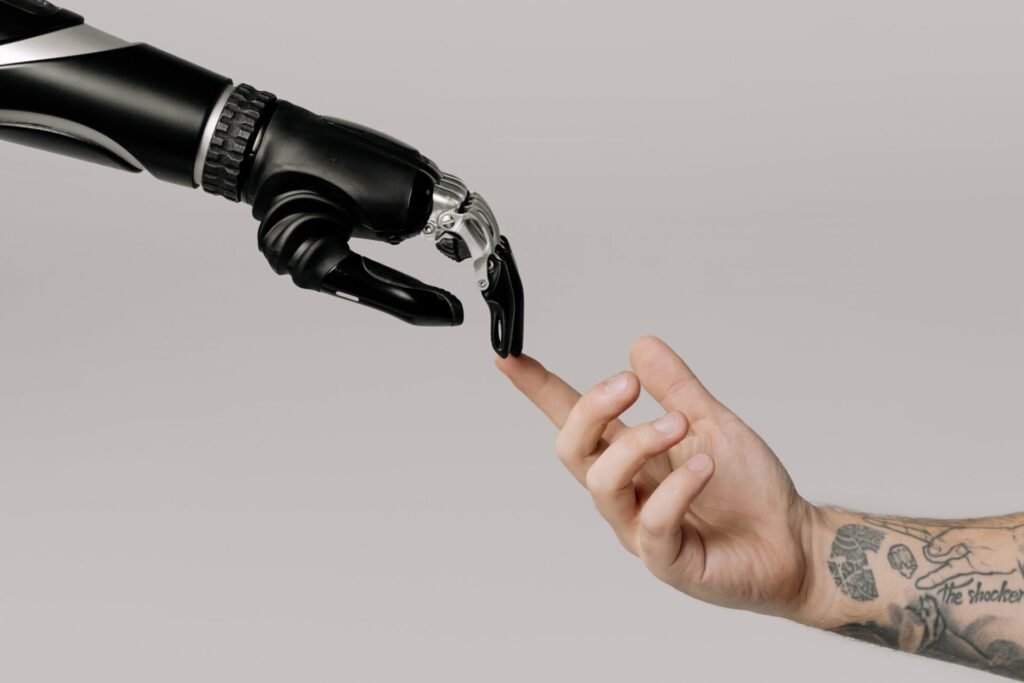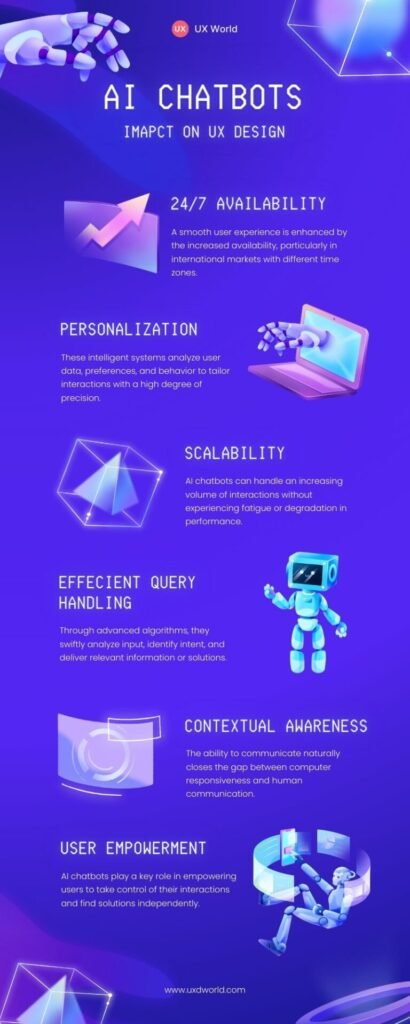Last Updated on January 2, 2024 by UX World
With the recent evolution of User Experience (UX) design, the integration of Artificial Intelligence (AI) has emerged as a game-changer, particularly with the advent of AI-powered chatbots. In this article, we will discuss how AI-powered chatbots play a crucial role in transforming UX design and enhancing user interactions with digital products.
What are AI Chatbots?
AI chatbots are smart computer programs that chat with people like humans do. These intelligent AI tools engage in human-like interactions by utilizing advanced technologies like Natural Language Processing (NLP) and Machine Learning (ML) to understand and respond in a way that feels natural to us. They make online conversations more like talking to a real person.
Unlike conventional chatbots, AI chatbots possess the ability to understand, interpret, and respond to user queries in a more sophisticated way by understanding the context behind queries.
Chatbots have evolved from simple rule-based systems to sophisticated AI-driven conversational agents. AI-powered chatbots have transformed how users engage with digital products through Natural Language Processing and Machine Learning. This shift has created a new era of personalized and intuitive user experiences.

The Impact of AI Chatbots on the User Interaction
AI chatbots have transformed the way users interact with businesses. Let’s take a closer look at some of the ways they have impacted user interactions.

24/7 Availability
Artificial intelligence chatbots are available to users 24/7 because they are not limited by time. In contrast to their human counterparts, these virtual assistants are always accessible, so users may ask for help or information whenever they need it. A smooth user experience is enhanced by this increased availability, particularly in international markets with different time zones.
Consistent User Experience
An essential feature of AI chatbots is consistency. Users are entitled to the same quality of service at all times of the day. This accuracy, tone, and manner of responses are all consistent. Users gain from consistent experience, which helps them to communicate with the chatbot with confidence and dependability.
Advanced Personalization
The depth of personalization achievable with AI chatbots goes beyond conventional expectations. These intelligent systems analyze user data, preferences, and behavior to tailor interactions with a high degree of precision. From recommending products to curating content, AI chatbots create a personalized journey that resonates with individual users, creating an atmosphere of exclusivity.
Cost-Effectiveness
AI chatbots bring forth a notable advantage in terms of cost-effectiveness. As virtual entities, they operate without the need for breaks, salaries, or additional resources associated with human counterparts. This inherent efficiency translates into significant cost savings for businesses, particularly in customer support and routine task automation.
Scalability without Constraints
The scalability of AI chatbots is a key aspect that distinguishes them in the digital world. These intelligent systems can handle an increasing volume of interactions without experiencing fatigue or degradation in performance. Whether catering to a growing user base or handling peak times, AI chatbots scale seamlessly, ensuring a consistent and high-quality user experience.
Efficient Query Handling
AI chatbots excel at processing and addressing user queries with efficiency. Through advanced algorithms, they swiftly analyze input, identify intent, and deliver relevant information or solutions. This efficiency not only saves users time but also contributes to a positive user experience by minimizing wait times and enhancing the overall responsiveness of digital interfaces.
Language Understanding and Contextual Awareness
The language skill of AI chatbots is a transformative element in user interactions. These chatbots are more than just language processors. They can judge intent and contextual cues. The ability to communicate more naturally closes the gap between computer responsiveness and human communication.
User Empowerment through Self-Service
AI chatbots play a key role in empowering users to take control of their interactions and find solutions independently. This concept revolves around the idea that users, when provided with the right tools and information, can navigate through processes and address queries without the need for human intervention.
For example, imagine a user exploring an e-commerce website who wants to track their order. Instead of contacting customer support, they can interact with the AI chatbot, input their order details, and receive real-time updates on the status of their delivery. This self-service capability streamlines the user journey and provides a seamless experience.
Conclusion
The integration of artificial intelligence into user experience design, particularly through AI-powered chatbots, has proven to be a transformative force. AI chatbots, utilizing advanced technologies like NLP and ML, go beyond conventional rule-based systems. Their ability to understand, interpret, and respond to user queries by understanding the context has redefined user interactions.
This evolution from simple chatbots to AI-driven conversational agents has moved to more personalized and intuitive digital experiences. In the ever-changing world of UX design, AI chatbots emerge as powerful tools, elevating the quality of user engagement in the digital world
Want to Learn UX Design?
- Try Interaction Design Foundation. IxDF offers online design courses that cover the entire spectrum of UX design, from foundational to advanced level. As a UX Design World reader, you get 25% off your first year of membership with the IxDF.
- The UI/UX Design Specialization from Coursera brings a design-centric approach to user interface and user experience design and offers practical, skill-based instruction centered around a visual communications perspective. By learning this Design Specialization, you can design high-impact user experiences for your customers.
Thanks for reading.
Subscribe for more related articles at UX World.
If you have any questions, contact us here: Facebook | YouTube | Twitter | Instagram | Linkedin



